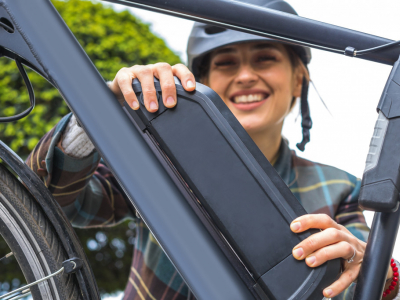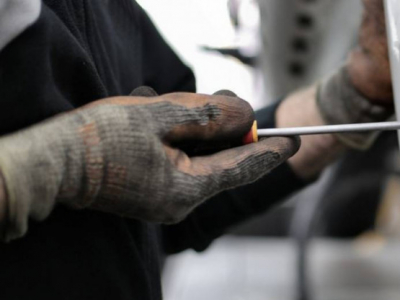All you need to know about lithium batteries for electric bikes

Today, lithium batteries are the most widely used in all our electronic devices. Electrically-assisted bicycles are no exception, and most of them are fitted with lithium batteries. Here's everything you need to know about lithium batteries for electric bikes.
What is a lithium battery made of?
A lithium battery contains cells soldered in series, and an electronic board, or BMS (acronym for Battery Management System), to manage their charging and discharging.
The Battery Management System or BMS

This is an electronic board that regulates the charging and discharging of the battery. It monitors a range of information, such as temperature, state of charge and discharge, voltage, etc. However, the BMS is not standard, and on low-cost batteries it does not perform all the functions described above. In fact, in this case, it only ensures that the maximum cell voltage is not exceeded and that the pack is completely discharged.
For batteries with a BMS that offer better value for money, opt for the following batteries: Hilltecks, Impulse, Panasonic.
On the other hand, when it comes to top-of-the-range batteries, BMSs can provide more information, such as the number of cycles performed by the battery, or the maximum charge/discharge current. The aim of the Battery Management System is therefore to manage the battery's power and regulate it in the event of misuse. So beware of products sold with a lithium battery without a BMS, which do not provide any regulation.
We invite you to take a look at our selection of top-of-the-range batteries equipped with intelligent BMS: Shimano, Bosch, Brose, Yamaha.
How do lithium cells work?
A lithium cell is made up of 3 elements that create an electric current: a positive electrode, a negative electrode and an electrolyte. Once stacked, the electrochemical reaction that is created gives rise to current. While there are several types of cell, each is defined by two properties:
- Voltage: Representing the nominal voltage of the cell, it determines the cell's power.
- Ampere-hour: Determines the nominal capacity of the cell, i.e. the current sent by the cell over a period of time.
The number of cells assembled will therefore define the voltage and amperage of the lithium battery.
What are voltages, ampere-hours and watt-hours?
The voltage of a battery corresponds to its electrical voltage. The most commonly used batteries on the market are 24, 36 or 48 volts. The higher the battery voltage, the greater the battery's sense of power.
In the 24V selection you'll find :
- Forerunner batteries
- The famous Tranzx BL03 battery
In the 36V selection you'll find :
In the 48V selection you'll find :
The amperage of an E-bike battery is its current. The higher the amperage, the longer your battery will last.
The watt-hour is the product of the voltage and the current, so in the case of a 24V-10Ah lithium battery, for example, the result will be 240W/h. The watt-hours correspond to the battery capacity.
Doctibike offers a catalogue of lithium batteries up to 20Ah/745Wh!
How do the cells behave during use?
During discharge (when you use your E-Bike): electrons escape from the negative electrode and power the electrical components of your nike. At the same time, ions move within the cell.
During charging: Your charger sends electrons through the negative electrode and they are counterbalanced by positive ions conducted to this same electrode.
When not in use: No current is flowing at this point, but electrochemical reactions are taking place, leading to a slight discharge of the cells. It is therefore important to recharge your battery every month to avoid this phenomenon.
What are the different types of lithium battery?
Lithium batteries can be classified into different categories, but above all into two main branches: lithium metal and lithium ion.
These variants of lithium batteries have different energy densities. Lithium metal batteries have an energy density of 110 Wh/Kg, compared with 90 Wh/Kg for lithium iron phosphate batteries and 180 Wh/Kg for lithium ion polymer batteries.
Each of these batteries, made up of different types of lithium-ion, has its own specific characteristics. Lithium-ion polymer batteries can be adapted to a large number of casing shapes, even the thinnest, because of their flexibility. They also have a lower recycling capacity than lead batteries (80% compared with 98% for lead batteries).
Lithium Manganese (LiMn) batteries :
These are the batteries you're most likely to find on your electric bike: they are known for their superior stability. This stability, along with shock resistance, explains why they are favoured over other types of lithium battery, such as lithium polymer.
The characteristics and components of lithium manganese batteries (nickel and cobalt, for example) are diverse, and make it possible to distinguish LiMn batteries that perform better and are more stable than others.
Lithium iron phosphate (LiFePO4) batteries :
These LiFePO4 batteries, made up of rectangular or cylindrical cells, are known for their efficiency and much longer life than other types of lithium battery. On the other hand, this robustness brings a negative point to the battery: weight. They are heavier, making them more suitable for scooters and tricycles. But thanks to their high capacity, they can withstand high discharge rates.
Lithium Polymer :
The lithium polymer battery (or LiPo or LiPoly) is the lightest, but poses certain problems in terms of stability, particularly because of the format in which the lithium is packaged. These are not cells, but sachets, which are flexible enough to adapt to all cases. But their format remains sensitive to shocks, making them easily damaged. Tests have shown that the disadvantages far outweigh the advantages of LiPo batteries: loss of capacity, risk of explosion, low resistance, etc.
At Doctibike, we recondition all brands of battery using only Litium Manganese cells.
This ensures that we offer the best quality reconditioning on the market.
Not sure whether to buy an electric bike battery or a reconditioned battery?
Contact our team of experts to find out if we can improve your battery's current capacity!















